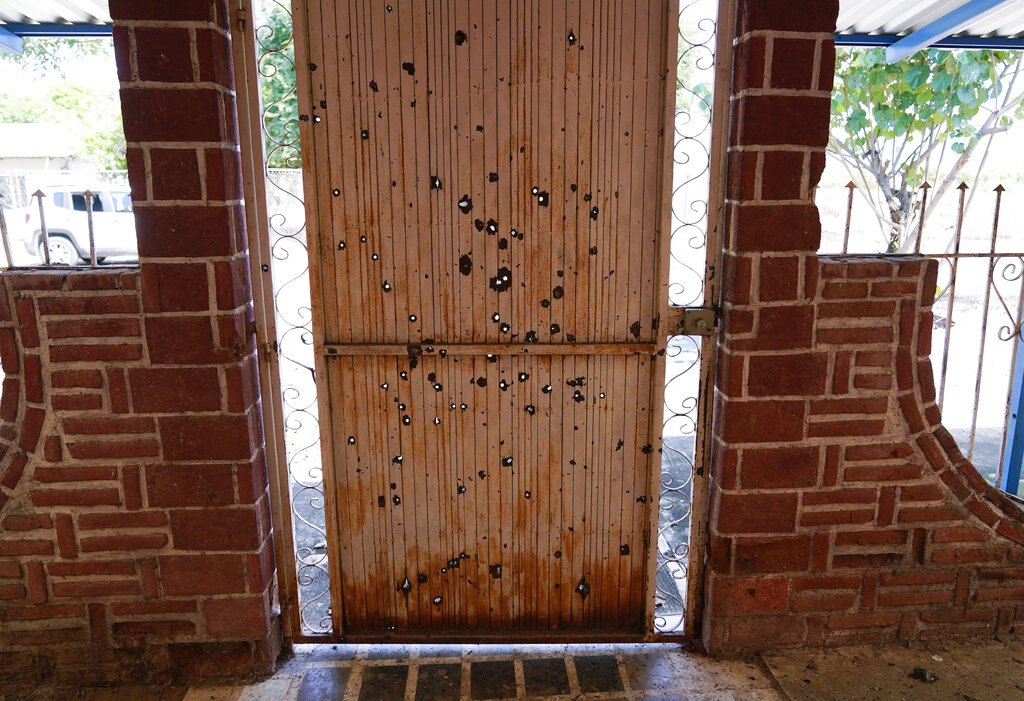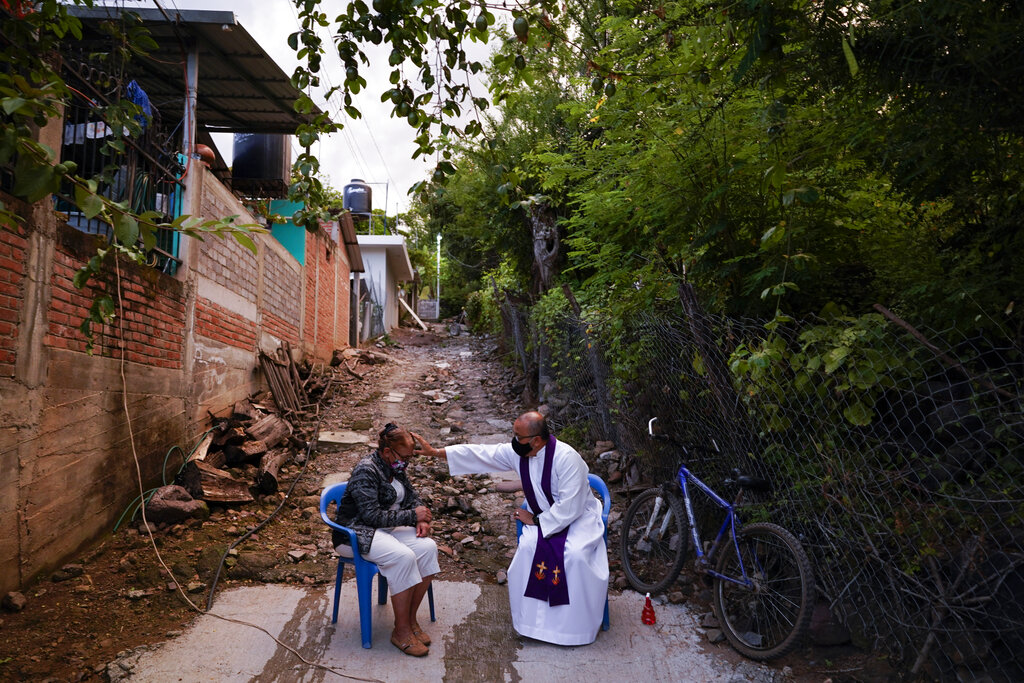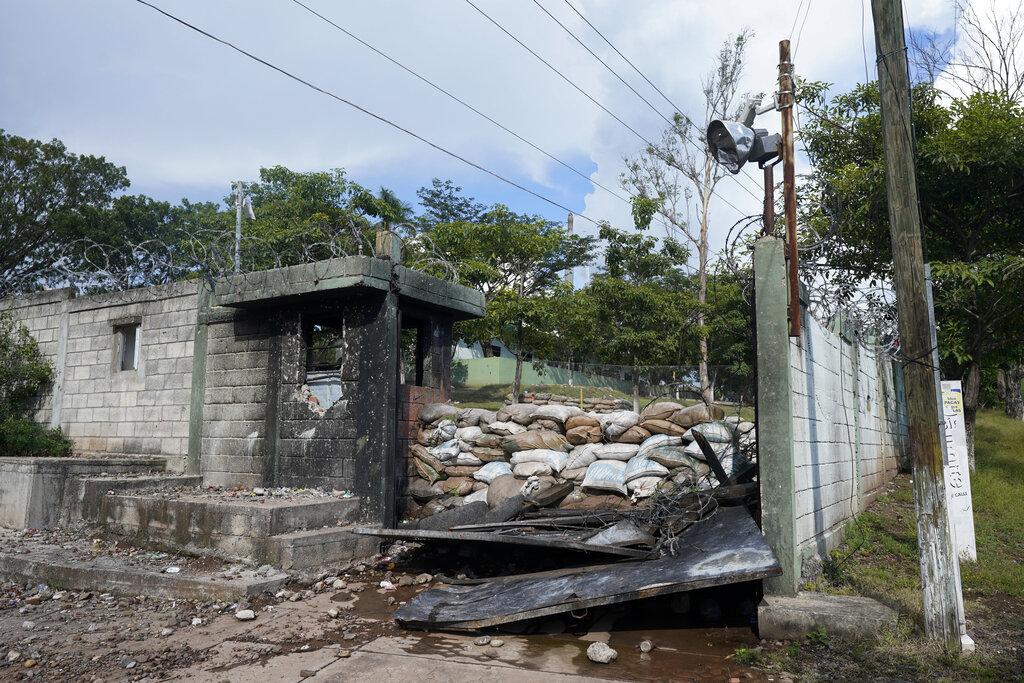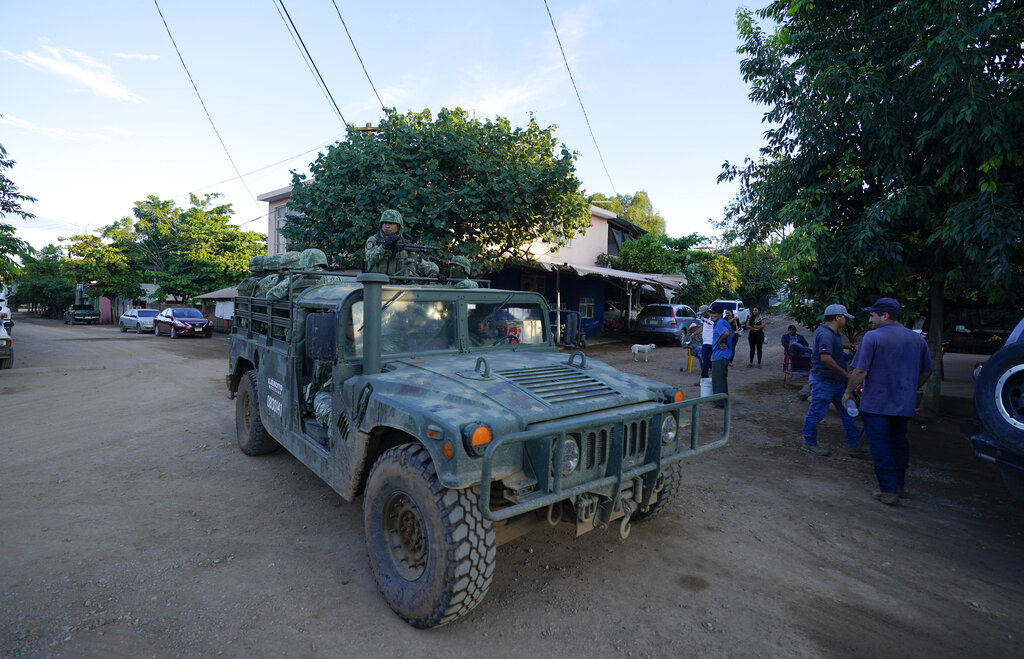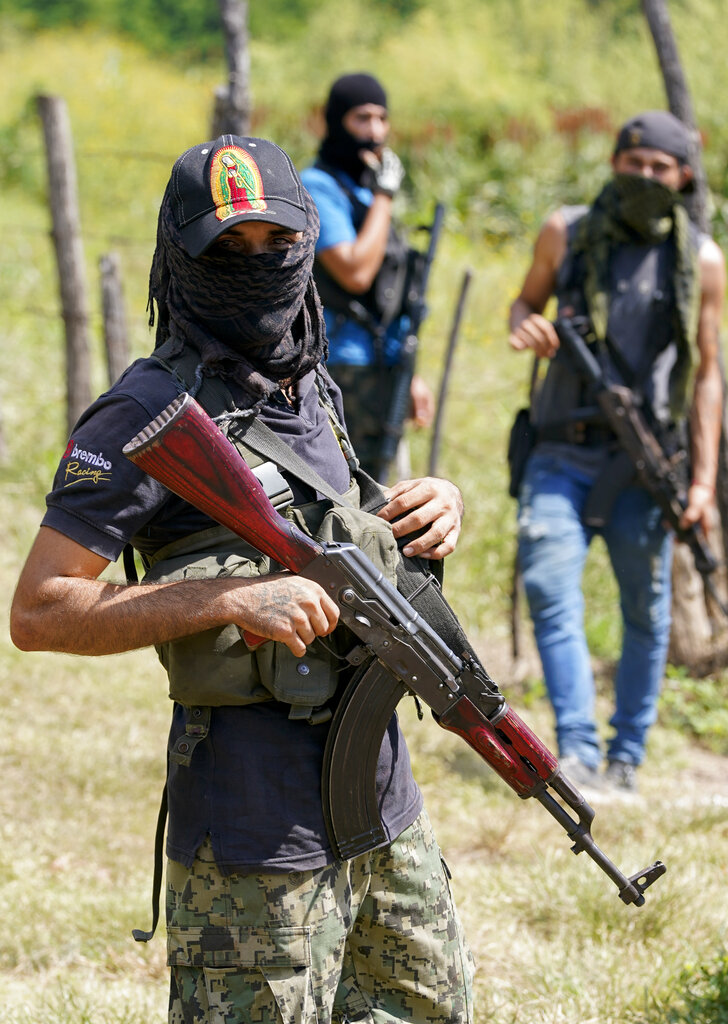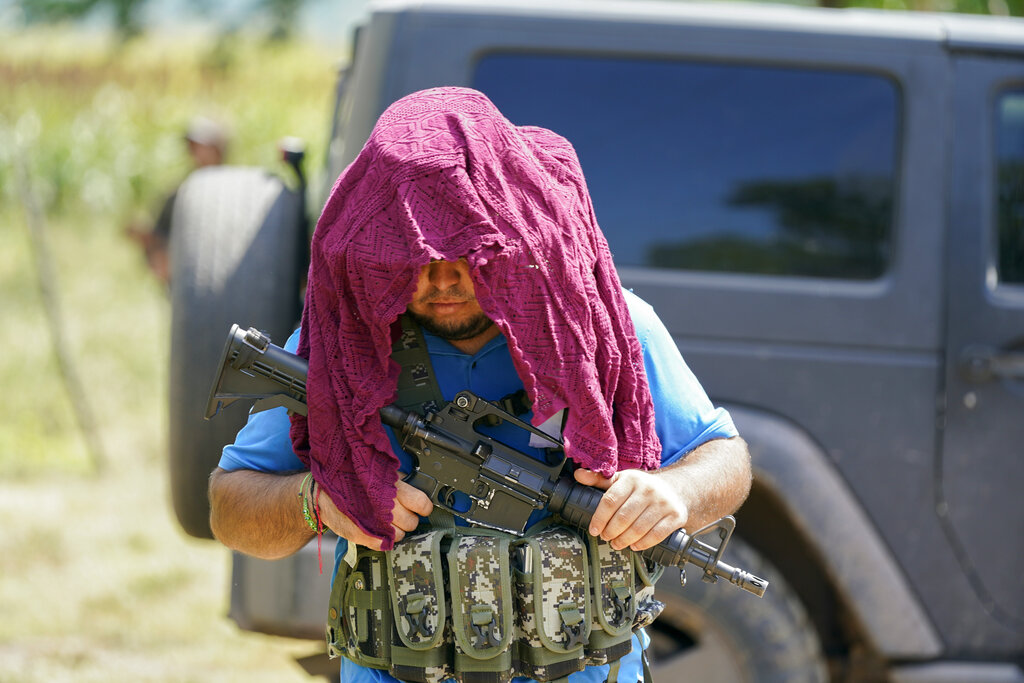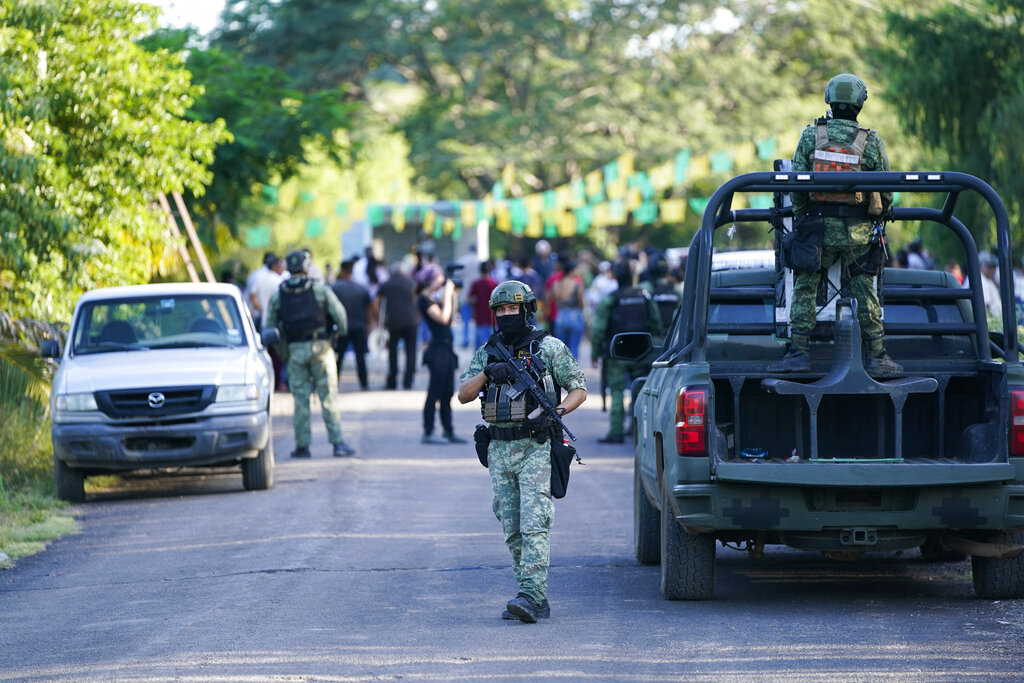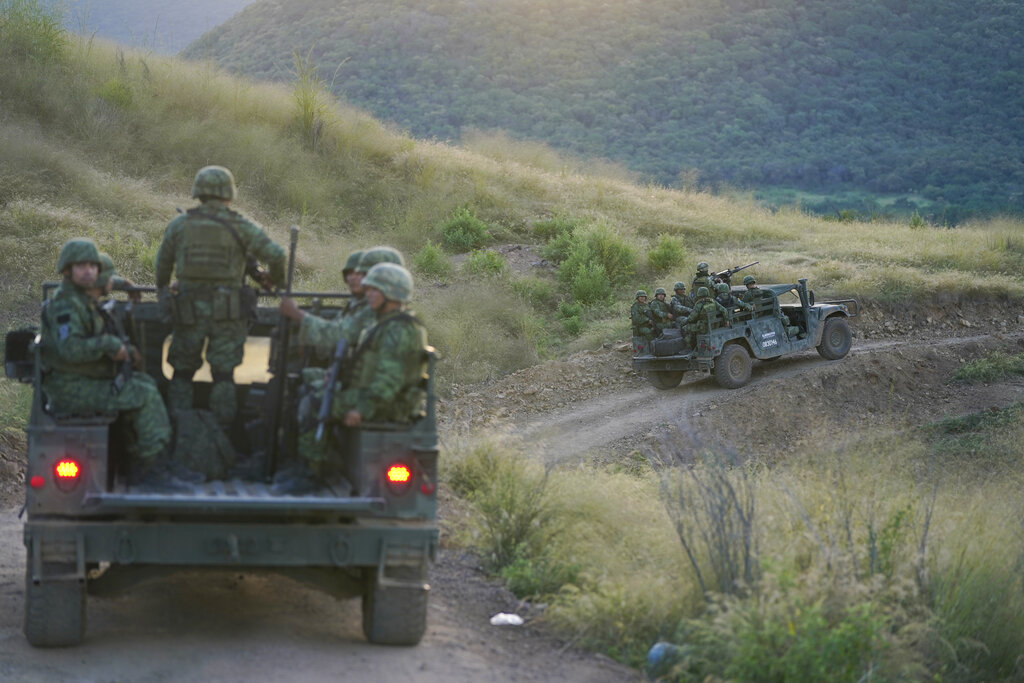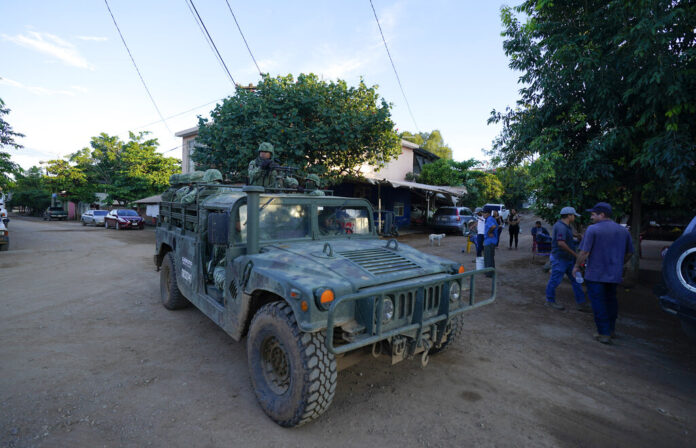
By MARK STEVENSON, The Associated Press
AGUILILLA, Mexico — In western Mexico a small squad of soldiers with about a half-dozen trucks and sandbag emplacements stands guard on a rural highway. In one direction, almost within earshot, one drug cartel operates a roadblock extorting farmers. In the other direction, a rival cartel carries out armed patrols in trucks bearing its initials.
The Mexican army has largely stopped fighting drug cartels here, instead ordering soldiers to guard the dividing lines between gang territories so they won’t invade each other’s turf — and turn a blind eye to the cartels’ illegal activities just a few hundred yards away.
At the first roadblock, set up by the Viagras gang that has long dominated the state of Michoacan, a truck stands parked across the highway and stacked sandbags protect cartel gunmen.
Every few hours, the gunmen roll back the truck to allow farmers through, but they interrogate each passing driver about how many crates of limes — the area’s most valuable product — or heads of cattle are being transported to market. The answers are written down in a book.
Local farmers say the Viagras are charging about $150 for each truckload of limes. They weigh and charge separately for each head of cattle. Further north, avocado growers are subject to similar protection payments on every box of fruit they ship.
“Be careful about what you publish,” the leader of the Viagras roadblock told journalists passing through. “I can monitor you on Facebook, and I’ll find you.”
About 2 miles down the same road, one formally enters another cartel’s territory, marked by squads of armed men and pickups and primitive homemade armored trucks bearing the letters “CJNG,” Spanish initials for the Jalisco New Generation Cartel.
Between them stand the soldiers, doing very little at all.
The cartel based in Jalisco state is invading neighboring Michoacan, causing thousands of farmers to flee, with some seeking asylum in the United States. While journalists could see few open threats in Jalisco’s newly taken town of Aguililla, Michoacan, local residents report Jalisco gunmen have abducted, and probably killed, youths they suspect of working for rival gangs.
Mexican Defense Secretary Gen. Luis Cresencio Sandoval has publicly said the soldiers are here to stop the Jalisco cartel’s incursions into Michoacan.
“We managed to make one of the cartels, the Jalisco, retreat to the border line of Jalisco,” Cresencio Sandoval said in October. The federal and state governments did not respond to repeated requests for comment on the strategy.
Michoacan’s seaport of Lazaro Cardenas is valued by the cartels as an entry point for precursor chemicals from China used to make methamphetamine and fentanyl. Its avocado orchards and iron ore mines are also a prime target for extortion by the Viagras, a gang that got its name from its founders’ liberal use of hair gel.
Jalisco’s leader, Nemesio “El Mencho” Oseguera, wants to take over all this, as well as regain control of his hometown; he was born in the Michoacan hamlet of Chila.
Security analyst Alejandro Hope says the government’s strategy is clearly “some sort of pact of non-aggression.”
“There is something like an increasingly explicit attempt to administer the conflict,” Hope said. “They (soldiers) are not there to disarm the two sides, but rather to prevent the conflict from spreading. The problem is that we don’t know where the army draws the line, what they are willing to accept.”
Just how passive has the army become, and how much abuse will it take? In the mountain township of Aguililla, now dominated by Jalisco, almost 200 soldiers have been barricaded into their command post by angry residents for four months.
The army has been flying in food for the troops by helicopter since townspeople used a grader and a bulldozer to block both entrances to the army barracks in late June. It is part of an increasing trend in Mexico: Soldiers have been taken hostage by townspeople because they know troops won’t even defend themselves under President Andrés Manuel López Obrador’s policy of “hugs, not bullets.”
Aguililla residents say they won’t let the soldiers out of their barracks until the army does its job of clearing the Viagra roadblocks that make things like medical care, food, fuel, electrical or telephone repairs impossible or expensive to get. Some residents have died because ambulances are either blocked or delayed at the roadblock.
“The most shameful thing is the absence of the government, which has become simply a spectator in a war that has left so many dead, so much destruction,” said the local priest in Aguililla, the Rev. Gilberto Vergara, describing the residents’ frustration with army’s reluctance to fight either of the two cartels.
“It just stands there watching, and at a given moment, when it can’t do anything else or when one side appears to be winning, it will act,” Vergara said. “But that is not the rule of law.”
That was a reference to the army’s only real action in recent months: In September, after a Jalisco cartel offensive against the nearby town of Tepalcatepec left five local vigilantes decapitated, the army sent in helicopters, reportedly armed with revolving-barrel machine guns that can fire thousands of rounds per minute, to push Jalisco back.
Since then, the army has taken up positions around Tepalcatepec, but has done the same thing as on the road to Aguililla: nothing.
“Why doesn’t the army advance? Why don’t they send in the helicopters again?” said a farmer in the hamlet of Taixtan, near Tepalcatepec, as he motioned down a dirt road in the direction of sorghum fields he cannot reach to harvest because Jalisco cartel gunmen posted on a nearby hill can hit the fields with their .50 caliber sniper rifles.
“Since they (soldiers) came, they haven’t fired a shot,” said the farmer, whose “self-defense” squad regularly exchanges fire with Jalisco. The farmer, like most others interviewed, refused to give his full name because of fears he could be identified and killed by the gangs.
Most of the farmers in Tepalcatepec feel they have been left alone to fight off an invasion.
Locals rely not on soldiers but on their own WWI-style trench warfare, combined with 21st century technology like exploding drones.
On a hilltop near Tepalcatepec , the vigilantes have built a bunker of concrete, steel beams and brick, topped with more concrete to protect against drones. They approach the bunker, known as “Achicumbo,” via meter-deep trenches to avoid sniper fire.
One farmer there showed shrapnel from a drone still lodged in the bumper of his truck; the devices cause terror, largely because they are unexpected and feel indiscriminate. Throughout the region, drone impacts launched by both sides can be seen in the metal roofs of structures opened like tin cans by the force of explosions. Each side has found “droneros” to operate the devices.
Nobody asks too much about where the Tepalcatepec vigilantes got their bulletproof cars and AR-15 rifles. There are rumors that the Sinaloa cartel has sent help, as part of that cartel’s nationwide war with arch-rival Jalisco. The only evidence is one “dronero” from Sinaloa state.
Pedro, who runs his family’s ranch in the nearby hamlet of Plaza Vieja, gazed out over the rich valley where his family has raised cattle and crops since his grandfather’s time and vowed “I’m not going to leave.”
“My umbilical cord is buried here,” he said, choking back tears. “We are not invading anyone else’s land. We are just defending what is ours, what our grandfathers built.”
One elderly woman said she was forced to leave her house and farm in a nearby hamlet in mid-September after Jalisco cartel gunmen showed up and told them they had two days to get out.
“Everything here belongs to el Señor Mencho,” the gunmen told her and her husband, whom they abducted and later released. “I walked along, crying and driving my cows in front of me,” she said.
Jalisco’s takeover of Aguililla has at least brought a modicum of peace; small gasoline shipments can make it through, and fuel is sold from plastic jugs on the streets. The town’s only gas station remains closed.
The man who oversees the blockade of the army barracks in Aguililla more or less reflects the Jalisco cartel’s view on the conflict.
“Look, there is a conflict between two cartels here,” said the man, who identified himself only as José Francisco. “The army should do its jobs, and fight both cartels, if it needs to. But it shouldn’t take the side of one of them.”
López Obrador has been seeking to avoid conflict since 2019, when he ordered the release of Ovidio Guzman, a son of imprisoned kingpin Joaquín “El Chapo” Guzman’, to avoid bloodshed after gunmen in Sinaloa took to the streets and started shooting to win the younger Guzman’s release.
But the government’s strategy of avoiding conflict has forced inhabitants to choose sides.
“If the government is absent, then the cartels take over. It’s not that we choose one, that we want this one or that one. There is a war between them, and they divide up the territory,” said Rev. Vergara. “If they are here, we have to live with them. That doesn’t make us accomplices, or applaud them or say one is better than another.”

